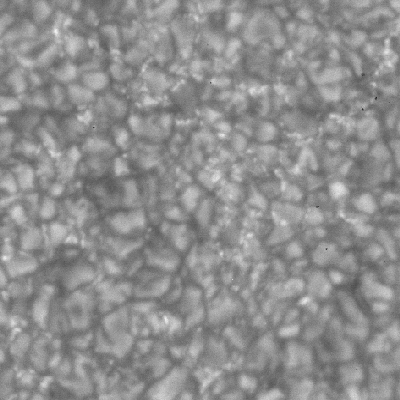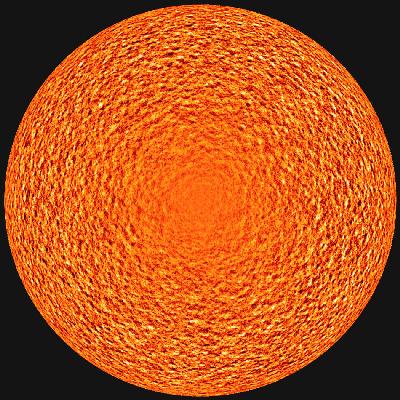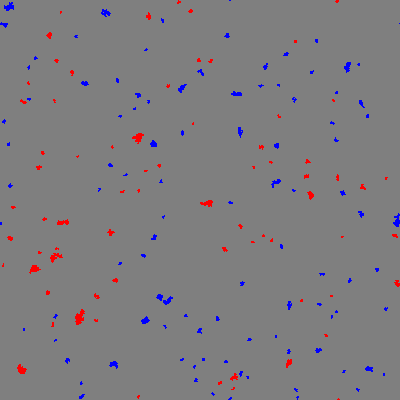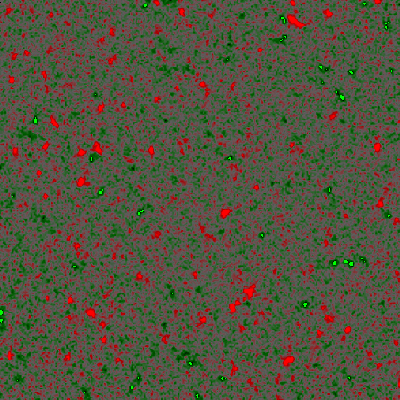Supergranulation and Scale Emergence

Energy transport in the outer 30% of the sun's radius takes place
primarily via thermally-driven convection. The physical parameter
regime characterizing solar interior conditions is such that this
convection is expected (and observed) to be strongly turbulent.
Observations of the sun's photosphere can reveal the surface
imprint of this convection, showing up as structures on more or less
well-defined spatial scale. Granulation (Figure 1A) is the only such scale
that is unambiguously convective, in that upflows (downflow) are spatially
well correlated with positive (negative) temperature fluctuations.
Supergranulation (see Figure 1B), a pattern on a scale 20-30 times larger,
is observed primarily in horizontal velocity and lacks the convective
signature seen in granulation. Supergranulation is usually assumed
to be a surface imprint of a deeper convective scale, but why
this scale (and no other) becomes imprinted in this fashion
remains unexplained.

Figure 1A: G-Band image of approximately 15000 by 15000
kilometer
piece of the solar photosphere, showing granulation. Bright areas
correspond to hotter rising fluid, and darker lanes to colder
sinking fluid. Supergranular cells have a typical length
scale of about 1000 km, and a lifetime of a few hours.
The small bright points are associated with strong concentration
of magnetic fields. Cropped from an image by R. Shine, Lockheed/Palo-Alto.
Click on the image to see an animation
from data taken at the Swedish Vacuum
Solar Telescope (mpeg 480KB).
|

Figure 1B:
Doppler image of the solar disk, showing line-of-sight velocity.
Solar rotation has been subtracted, and acoustic oscillations have
been removed by temporal averaging. The remaining pattern is
called supergranulation, and is a primarily horizontal flow,
as evidenced by the fact that the signal is strongest near
the solar limb and vanishes at disk center.
Image by D. Hathaway using data from SOHO/MDI.
|
Using Monte Carlo simulations, we have been exploring the
possibility that supergranulation is an emergent length scale,
building up as small magnetic elements are randomly displaced by the
granular flow, occasionally colliding and aggregating to
form larger magnetic clusters that, we postulate, can seed the
supergranular downflow structure. The simulations are carried
out on a 2D computational plane representing a piece of the
solar photosphere, and share many similarities with diffusion-limited
aggregation, a well-studied mechanism in the theory of pattern formation.
Our simulations (see Figure 2
for a sample) indicate that for reasonable model parameter values,
solar-like distributions of magnetic flux concentrations are produced,
with
length scales commensurate with supergranulation can indeed
emerge in this manner.

Figure 2A: A typical spatial distribution of clusters produced
by our Monte carlo simulation. Blue and Red code the magnetic polarity.
Only clusters of size larger than 10 magnetic elements are shown.
Click on the image to see an animation (mpeg, 19MB).
|

Figure 2B:
High resolution magnetogram of a quiet Sun region, away from
active regions or other large-scale magnetic structures, showing
magnetic flux concentrations of opposite polarities (red/green).
Magnetographic data from SOHO/MDI.
|
We are currently investigating whether the same aggregation
process, fed by the decay of sunspots and active regions, could
form plage-like structures, and how the characteristics of
such structures --or any other emerging scales-- are affected
by the injection rate of small magnetic structures. Long term
plans include the coupling to simulations of total solar irradiance,
also in development in our group, with the aim
of building a working model for the contribution of the magnetic
network to solar irradiance variations, that could be extended
all the way back to the Maunder Minimum.
Who in the group works on this:
Ashley Crouch,
Paul Charbonneau.
Kim Thibault.
Recent publications by group members on this topic:
- Thibault, K., Crouch, A., Charbonneau, P. 2006,
Solar supergranulation as a result of granular advective
interaction: a numerical simulation.
Canadian Undergraduate Physics Journal, 4, 7-10
- Crouch, A., Charbonneau, P., & Thibault, K. 2007,
Supergranulation as an emergent length scale,
The Astrophysical Journal, 662, 715-729
- Thibault, K., Charbonneau, P., & Crouch, A. 2011,
The buildup of a scale-free photospheric magnetic network,
The Astrophysical Journal, 757, id187

